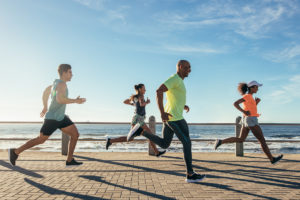Exercise/Class Formats
A Great Start to Indoor Cycling
The best indoor cycling instructors get it: The workout isn’t about you; it’s about the people you’re coaching. Your class is an opportunity to shine a light on others and help them feel successful. It’s a forum for building confidence, inner strength and community.
An engaging start is like a handshake; it introduces you to the riders. It’s your time to capture your audience by rolling out the carefully constructed plan you’ve created especially for them.
Two of a Kind
When Colleen Evans wanted to improve her strength while healing from Lyme disease, her doctor knew exactly who could help her: fellow patient and personal trainer Shona Curley.
Like Colleen, Curley had been diagnosed with Lyme disease and was coping with its symptoms.
A Barre-Cardio-Core Class
When you take the strong, efficient movements of barre and mix in cardiovascular intensity and a comprehensive core routine, you get a winning combination for a full-body workout that appeals to a wide variety of people. Traditional barre classes use small, repetitive movements from a standing posture to work on balance while strengthening the lower body. Simultaneously, the upper body receives graceful range-of-motion benefits.
Variable Resistance Training With Deadshifts and Deadlifts
It’s 2 a.m. Your 3-month-old son is screaming at the top of his tiny lungs, waking up everyone in the household. Begrudgingly, you get out of bed and zombie-walk over to your son’s crib in the next room. Your body aches, you haven’t slept in days, and now you must bend over to pick up a squirming child in the dead of night. Unfortunately, your son’s not a great strength coach and doesn’t allot enough warmup time to prepare your body for a deadlift.
Once-Weekly Strength Training for Older Adults
Great news for healthy older adults who may not be able to weight-train more than once a week. For 65- to 75-year-old men and women, supervised whole-body resistance training once weekly for 6 months led to significantly less inflammation, lower blood pressure and blood sugar levels, and better overall well-being.
Location Affects Fitness Activity Choice
While group fitness is most popular in Salt Lake City, Los Angeles and New York City, using weights or resistance machines is most widespread in San Diego, Chicago, and the Cleveland, Akron and Canton areas of Ohio.
Virtual-based training—either streamed live or recorded in advance—is growing in popularity. The most prevalent home-based activities include body-weight exercise, Pilates, stretching, tai chi and yoga.
Have a Ball Workout
This fun format incorporates exercise balls into cardiovascular and strength intervals. Each 8-minute round uses either a stability ball or a medicine ball, 4 minutes of high-intensity cardio training (combined), and about 4 minutes of strength-focused work (combined). For those who also enjoy a core challenge, this class delivers.
How Strength Training Impacts Metabolism
Strength training (or resistance training) does much more than build strong muscles and bones. Research in the past few years has confirmed that lifting weights changes human metabolism in ways that improve health and well-being. Resistance exercise improves resting metabolic rate and cardiorespiratory fitness. Indeed, some authors call strength training an exercise therapy program (Strasser & Schobersberger 2011).
Sample Class: Barre-Cardio-Core
When you take the strong, efficient movements of barre and mix in cardiovascular intensity and a comprehensive core routine, you get a winning combination that appeals to a wide variety of people. Traditional barre classes use small, repetitive movements from a standing posture to work on balance while strengthening the lower body. Simultaneously, the upper body receives graceful range-of-motion benefits. These movements prepare the body to progress to more intense cardio work, and the core section challenges the center from all directions.
Breath and Movement for Core Stability
When your participants ask about their core muscles, they’re most likely referring to the lauded “six-pack.” As a fitness instructor, you may think about transversus abdominis, obliques and pelvic-floor muscles. But almost everyone tends to forget about the diaphragm.
Stop and Smell the Daisies
CLIENT: Brenda Badish
PERSONAL TRAINER: Kelly Fletcher
LOCATION: KFit Studios, Brighton, Michigan
Brenda Badish had almost given up hope that she could regain her health. “I figured I was a few weeks away from pushing up the daisies,” she says.
Short, High-Intensity Weight Training and Diabetes Risk
Preliminary research on high-intensity training benefits may motivate people who prefer short training sessions and are concerned about diabetes risk. University of Glasgow researchers in Scotland found that 15-minute strength training workouts, done three times a week for 6 weeks, dramatically improved insulin sensitivity and boosted muscle size and strength among 10 young, overweight men.
Gender Differences in Fitness and Brain Function
Many studies show that cardiorespiratory fitness improvements boost brain fitness in later life. New research in the Journal of Applied Physiology (2019; doi:10.1152/japplphysiol.01046.2018) reveals that effects may differ between men and women.
Exercise Promotes Brain Fitness in Everyone
Much research on cardiovascular training for brain fitness focuses on benefits to older adults (see below). A recent randomized clinical trial using parallel groups found that cardio training also increases executive function in adults as young as 20 years old.
Cardio Training and Weight Loss
A systematic review of 77 studies suggests that while both interval training and continuous moderate-intensity exercise are effective for fat loss, interval training may produce results in a more time-efficient manner. Researchers from Brazil and England conducted the review to identify what type of exercise—continuous moderate-intensity (MOD), high-intensity interval training (HIIT) or sprint interval training (SIT)—is best for weight loss.
Can Exercise Prevent Depression?
Fifteen minutes of vigorous activity or approximately 1 hour of moderate activity (like walking or gardening)—or a combination of light and vigorous physical activity—may significantly reduce risk of major depression, according to a study published in JAMA Psychiatry (2019; doi:10.1001/jamapsychiatry.2018.4175).
June 2019 Question of the Month: HIIT Programs
What is the status of HIIT programming at your facility? What programs, if any, are you offering, and are they growing or declining in popularity or remaining the same? Are they popular with a specific demographic group, or do they have broad appeal? Share your insights on HIIT programs and your experiences with them.
We want to hear from you!
Email executive editor Joy Keller, jkeller@ideafit.com.
UK Med School Includes Physical Activity Education
Lancaster Medical School in Lancaster, England, has been acknowledged throughout the United Kingdom and by the World Health Organization Europe for being the first medical school in the U.K. to integrate guidelines on how to prescribe physical activity. The initiative is referred to as the “Movement for Movement.”
Stair-Climb Your Way to Health
You may want to start recommending exercise snacking, particularly for people who believe they have no time for training. A few minutes of vigorous stair climbing, spread out in three bouts per day, three times a week, improved cardio fitness in formerly inactive young adults. McMaster University and UBC Okanagan researchers in British Columbia conducted the 6-week study.
Weighted Step-Training Benefits
If you’re looking for a different way to progress a client’s lower-body strength, consider adding a weighted vest to the training program. Specifically, wearing a progressively heavier weighted vest while stepping may be effective in boosting lower-body power and functional ability among older women.



















